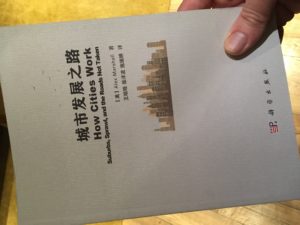Here’s the text of an essay I wrote wow, 26 years ago. I’m putting it here, because it’s hard to access online. Although here is a link, that may or may not work in the future.
DREAM BOOK UNLOCKS PARIS’ SECRETS
Published: October 18, 1992
Section: DAILY BREAK, page G9
Source: Alex Marshall, Staff writer
© 1992- Landmark Communications Inc.
PARIS – TO UNDERSTAND a city, to know a city, you need to unlock its secrets. Finding the key takes time. Sometimes it means walking for months, looking for the small street that leads to the corner where the old men play dominoes at a sidewalk table.
I didn’t have months. In Paris, I just had five weeks. Before I left, I searched for a book that would open Paris’ door. A regular guidebook wouldn’t do; I tried a novel, a memoir, with no real luck. Before I boarded the plane in Washington, D.C., I bought a new paperback with a gold cover. “Paris Dreambook – An Unconventional Guide to the Splendor and Squalor of the City” was less of a guide than a series of fantastical essays about the author’s life in Paris, told through a character called “the peasant.”The author was Lawrence Osborne. He was pictured inside, a thin, lean, unsmiling young man standing against a grafitti-covered wall.After reading a few chapters, I figured Osborne had made most of the stuff up. He led me on a dark journey through Paris’ neo-hip art and literary worlds, its brothels and Arabian bath house, its gastronomical obsessions and its tiny ignored neighborhoods. He used people he had met and his own imagination as entry points. He wrote in half-page, run-on sentences.It wasn’t long before I became obsessed with the book. I started running down Osborne’s tales. I even went to his apartment building, whose occupants and appearance he describes in loving detail.The building was on a small, bumpy narrow street that twisted its way down a hill from a small plaza and church at the Place des Abbesses. Above the doorway to the otherwise plain building was a statue of a reclining nude woman.Osborne had departed a year or so back. But the concierge was there, the same one he had devoted a whole chapter to. Osborne described the man as a mixture of magician, master chef, knife fighter and enlightened Buddha:“On the ground floor, safely withdrawn from the world when it suits his purposes behind a curtain of red and yellow beads behind his door, there is a laxer follower of the true path, a Tanzanian Ali, concierge to the building, whose hidden identity, for those who wish to probe his mysteries, is Aladdin. This can easily be confirmed by entering his single room tucked under the stairs, in the middle of which, amid the paraphernalia of many assumed lives, Arabic dictionaries of medicinal spells, hi-fi equipment, boxes of rabbits’ feet, cabinets of tropical oils and herbs, cooking pots scented with clove oil, pots of lemon grass and cardamom pods, dense clothes racks and various firearms, hangs a a khaki regulation tropics British army uniform decorated with coloured bands.”Ali, a small, elderly man in an Arabian-style cap and shirt, greeted me at the iron outer door. He had an unflinching solemnness about him as he inquired about my motives for being there.Amazingly, Ali did not know about Osborne’s book or that he was in it. About six months earlier, he said, another young man, another journalist it seemed, had come searching for Osborne. That man had said something about a book, too.Soon I was squeezed inside Ali’s tiny room, reading him the entire chapter. His room was just as Osborne described: a miniscule cubicle neatly crammed full of books, records and knickknacks with a tiny kitchen at one corner. Over small cups of strong coffee, Ali confirmed Osborne’s tales and added a few more.Yes, he had served in the British army during World War II and been decorated for bravery. The medal-studded uniform hung by the bed, just as Osborne described.Yes, he had been in prison a few years in Zanzibar. He had been a police inspector in the government but was caught on the wrong side of a coup d’etat.Yes, he did dabble a little in black magic. He had shown Osborne a few spells, but he didn’t like to talk about that.Yes, he had appeared in a few pornographic movies in Athens in his early ’50s. He had played a Nubian slave, just as Osborne said, who made love to an elegant mistress. Would I like to see the film?Yes, he had been involved in a few scrapes with intruders. He showed a gray knife scar on his belly.This little man in this tiny room had probably led a fuller life than I ever would, full of the rich adventures that satiate the soul. Ali, though, also seemed a little lonely. He jumped at the chance to talk. He showed me pictures of his nine children and of a fleshy young woman hugging him on the beach.“How do you say it in English?” he asked. “She is my concubine.”Ali was about 70 percent flattered and 30 percent annoyed about appearing in the book. Osborne had never mentioned the project.“He was such a nice boy,” Ali said. “Very quiet. We would eat together often. He would ask me questions and write in a notebook. But I never dreamed he was writing a book.”He was sad that he didn’t have a picture of Osborne. Could I get one for him? Or his address?I said I would try. It was past midnight when I left the building and walked down the narrow, twisted street back to my rented room in what now seemed a plainer, and less exotic quarter of Paris.
© 1992- Virginian-Pilot
Questions? For NewsLibrary billing, call 1-800-896-5587 / E-mail us
PilotOnline.com

